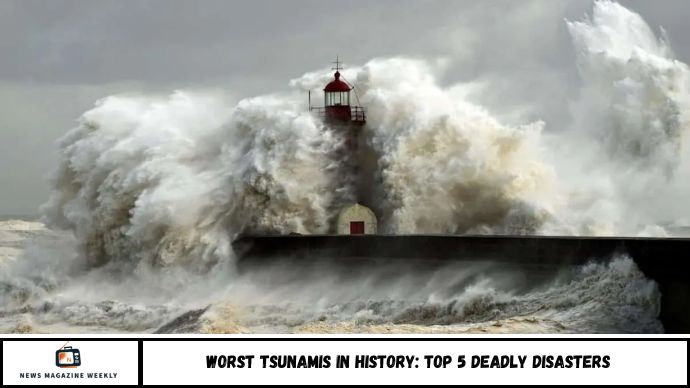5 Worst Tsunamis in History That Changed the World
How do waves rising taller than buildings erase entire cities in seconds? And what can we learn from the most catastrophic tsunamis ever recorded?
Tsunamis are among the most devastating natural disasters on Earth. Triggered by undersea earthquakes, volcanic eruptions, or landslides, these massive waves have taken hundreds of thousands of lives and reshaped nations. In this article, we’ll explore the five worst tsunamis in history, ranked by their death toll and overall impact. We’ll also look at what caused them, the areas affected, and what these disasters teach us about preparedness and early warning systems.
This article highlights the five deadliest tsunamis in recorded history, detailing their causes, scale, death tolls, and long-term consequences. Using historical records and recent data, we analyze how these catastrophes unfolded and what modern science is doing to prevent future tragedy. Whether you’re a student, traveler, or concerned citizen, understanding these events is essential to appreciating the power of nature and the importance of disaster readiness
What Is a Tsunami? A Quick Refresher
Before we dive into the worst cases, here’s what defines a tsunami:
- Caused by: Underwater earthquakes, landslides, volcanic eruptions
- Wave speed: Up to 500–800 km/h (310–500 mph)
- Wave height near coast: Can exceed 30 meters (98 feet)
- Impact: Massive flooding, destruction of infrastructure, loss of life
Now let’s explore the worst of the worst.
1. 2004 Indian Ocean Tsunami – The Deadliest Ever
- Date: December 26, 2004
- Death Toll: 230,000+ people
- Magnitude: 9.1–9.3 earthquake off the coast of Sumatra
- Countries Affected: Indonesia, Thailand, Sri Lanka, India, Maldives, Somalia
This tsunami was triggered by one of the strongest earthquakes ever recorded. Waves reached 30 meters high and traveled across the Indian Ocean at jetliner speeds. Entire towns in Indonesia were wiped off the map, and millions were left homeless.
Key fact: It led to the development of the Indian Ocean Tsunami Warning System.
2. 2011 Tōhoku Tsunami, Japan – Technological Disaster
- Date: March 11, 2011
- Death Toll: 18,500+
- Magnitude: 9.0 earthquake off the east coast of Japan
- Impact: Massive damage + Fukushima nuclear crisis
Waves up to 40 meters (131 feet) devastated Japan’s northeastern coast. The tsunami disabled the Fukushima Daiichi Nuclear Plant, causing a meltdown and long-term radiation crisis.
Key fact: Damage exceeded $235 billion—the costliest natural disaster in history.
3. 1755 Lisbon Tsunami – Europe’s Wake-Up Call
- Date: November 1, 1755
- Death Toll: 40,000–50,000
- Trigger: Earthquake in the Atlantic Ocean
- Cities Affected: Lisbon (Portugal), parts of Spain and Morocco
The 1755 Lisbon tsunami followed a powerful earthquake and fire, destroying much of Portugal’s capital on All Saints’ Day. Churches collapsed with worshippers inside. Waves as high as 20 meters struck coastal cities.
Key fact: Sparked scientific study of earthquakes and modern seismology.
4. 1883 Krakatoa Tsunami – Volcanic Fury
- Date: August 27, 1883
- Death Toll: Over 36,000
- Cause: Eruption of Krakatoa volcano, Indonesia
- Waves: Up to 37 meters high
The eruption obliterated most of the island of Krakatoa. The resulting tsunamis traveled across the Indian Ocean, even reaching South Africa. The sound of the explosion was heard 3,000 miles away.
Key fact: The eruption affected global climate for years, lowering temperatures worldwide.
5. 1908 Messina Tsunami – Italy’s Deadly Shock
- Date: December 28, 1908
- Death Toll: 100,000+ (earthquake + tsunami)
- Location: Messina, Sicily, and Reggio Calabria, Italy
- Wave Height: 10 meters
Following a powerful 7.1 magnitude quake, a tsunami swept through the narrow Strait of Messina. Entire neighborhoods were swallowed by the sea.
Key fact: One of the most lethal natural disasters in European history.
Lessons Learned from History’s Worst Tsunamis
These disasters taught scientists and governments hard lessons:
- Early warning systems save lives: Countries now invest in seismic sensors and tsunami alerts.
- Preparedness matters: Community evacuation plans and education campaigns reduce casualties.
- Climate and geology affect risk: Coastal development near subduction zones remains dangerous.
FAQs
1. What causes tsunamis?
Most tsunamis are caused by undersea earthquakes, but volcanic eruptions and landslides can also trigger them.
2. What was the deadliest tsunami in history?
The 2004 Indian Ocean tsunami holds the record with over 230,000 deaths across multiple countries.
3. How fast can a tsunami travel?
In deep water, tsunami waves can travel up to 800 km/h (500 mph).
4. Can tsunamis be predicted?
We can detect likely tsunami events with early warning systems, but we cannot predict exact times or places in advance.
5. Where do tsunamis happen most often?
Tsunamis are most common in the Pacific Ring of Fire, where many tectonic plates meet.
6. How can you stay safe during a tsunami?
Heed all evacuation orders, move to high ground, and stay informed via official alerts and weather apps.
Conclusion
The five worst tsunamis in history were more than just deadly waves—they were moments that reshaped regions, changed scientific understanding, and sparked global safety improvements. As sea levels rise and coastal populations grow, the risks increase. But so do our tools to face them.

